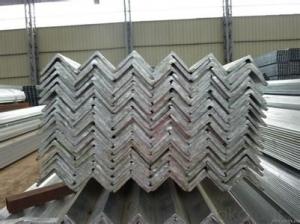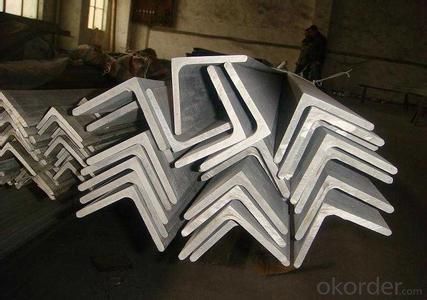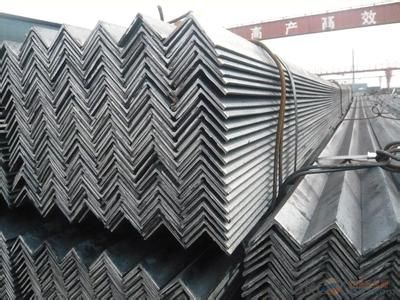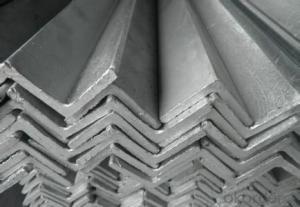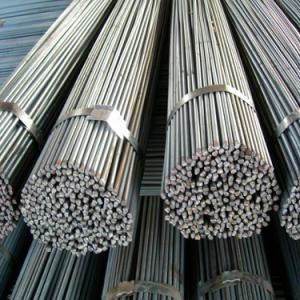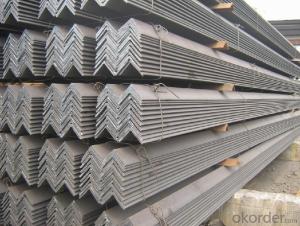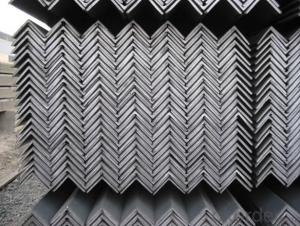Angle Steel Hot Rolled High Quality ASTM A36 25-250MM
- Loading Port:
- Tianjin
- Payment Terms:
- TT OR LC
- Min Order Qty:
- 25 m.t.
- Supply Capability:
- 20000000 m.t./month
OKorder Service Pledge
OKorder Financial Service
You Might Also Like
Specification
Product Description:
OKorder is offering Angle Steel Hot Rolled High Quality ASTM A36 25-250MM at great prices with worldwide shipping. Our supplier is a world-class manufacturer of steel, with our products utilized the world over.
Product Applications:
According to the needs of different structures, Angle can compose to different force support component, bridges, transmission towers, hoisting machinery and transport machinery, ships, industrial furnaces, reaction tower, container frame and warehouse etc
Product Advantages:
OKorder's Angle Steel Hot Rolled High Quality ASTM A36 25-250MM are durable, strong, and resist corrosion.
Main Product Features:
· Premium quality
· Prompt delivery & seaworthy packing (30 days after receiving deposit)
· Corrosion resistance
· Can be recycled and reused
· Mill test certification
· Professional Service
· Competitive pricing
Product Specifications:
Manufacture: Hot rolled
Grade: Q195 – 235
Certificates: ISO, SGS, BV, CIQ
Length: 6m – 12m, as per customer request
Packaging: Export packing, nude packing, bundled
Sizes: 25mm-250mm | ||||||||||||
a*t | ||||||||||||
25*2.5-4.0 | 70*6.0-9.0 | 130*9.0-15 | ||||||||||
30*2.5-6.6 | 75*6.0-9.0 | 140*10-14 | ||||||||||
36*3.0-5.0 | 80*5.0-10 | 150*10-20 | ||||||||||
38*2.3-6.0 | 90*7.0-10 | 160*10-16 | ||||||||||
40*3.0-5.0 | 100*6.0-12 | 175*12-15 | ||||||||||
45*4.0-6.0 | 110*8.0-10 | 180*12-18 | ||||||||||
50*4.0-6.0 | 120*6.0-15 | 200*14-25 | ||||||||||
60*4.0-8.0 | 125*8.0-14 | 250*25 | ||||||||||
FAQ:
Q1: Why buy Materials & Equipment from OKorder.com?
A1: All products offered byOKorder.com are carefully selected from China's most reliable manufacturing enterprises. Through its ISO certifications, OKorder.com adheres to the highest standards and a commitment to supply chain safety and customer satisfaction.
Q2: How do we guarantee the quality of our products?
A2: We have established an advanced quality management system which conducts strict quality tests at every step, from raw materials to the final product. At the same time, we provide extensive follow-up service assurances as required.
Q3: How soon can we receive the product after purchase?
A3: Within three days of placing an order, we will begin production. The specific shipping date is dependent upon international and government factors, but is typically 7 to 10 workdays.
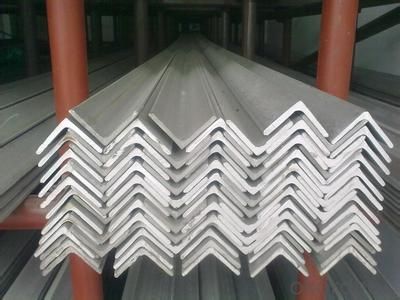
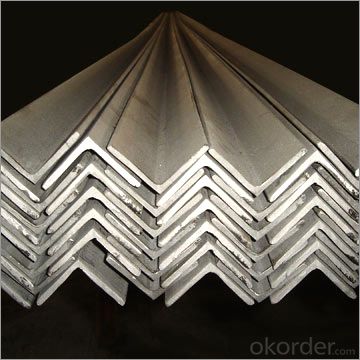
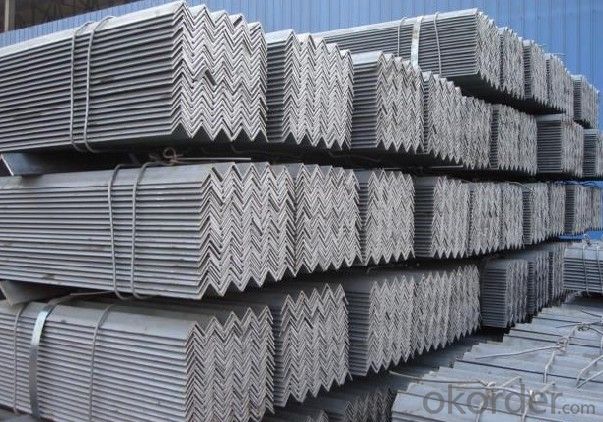
- Q: Can steel angles be used for framing?
- Yes, steel angles can be used for framing. Steel angles are commonly used in construction for structural framing and support due to their strength, durability, and versatility. They can provide stability and reinforcement to various building structures, making them suitable for framing applications.
- Q: Can steel angles be used for modular construction?
- Absolutely, modular construction can make use of steel angles. Steel angles are widely utilized in the construction industry due to their robustness, adaptability, and cost-efficiency. When it comes to modular construction, steel angles find application in constructing frameworks, supporting structures, and establishing connections between modules. By providing stability and ensuring structural integrity, they guarantee the durability and safety of the modular units. Moreover, steel angles can be effortlessly fabricated and tailored to meet the precise design prerequisites of modular construction ventures. In summary, steel angles are a practical and frequently employed material in modular construction, owing to their multitude of advantages and suitability for the construction process.
- Q: How do you determine the axial capacity of a steel angle?
- In order to ascertain the axial capacity of a steel angle, one must consider several factors. First and foremost, it is crucial to determine the yield strength of the steel angle. Typically, this information is provided by the manufacturer and can be found in material specifications. The yield strength denotes the maximum stress that the steel angle can endure without experiencing permanent deformation. Following that, the cross-sectional area of the steel angle must be computed. This can be achieved by measuring the angle's dimensions, such as the thickness and the length of its legs. The cross-sectional area is then obtained by multiplying the thickness by the sum of the two leg lengths. Once the cross-sectional area is ascertained, the axial capacity can be calculated by multiplying the yield strength by the cross-sectional area. This will determine the maximum load that the steel angle can bear in a purely axial direction without failure. It is important to bear in mind that there are additional factors that can impact the axial capacity of a steel angle, including the presence of holes or notches, the slenderness ratio, and the loading conditions. Therefore, it is advisable to consult relevant design codes, standards, or engineering handbooks for more comprehensive guidance and to account for these supplementary factors.
- Q: What are the limitations of using steel angles?
- There are several limitations associated with the use of steel angles in various applications. Firstly, steel angles have a limited load-bearing capacity. The weight and pressure that can be safely supported by a steel angle are determined by its size, shape, and material composition. If the load exceeds the weight-bearing capacity of the angle, it can lead to structural failure or deformation. Secondly, steel angles are susceptible to corrosion. They are typically made of carbon steel, which can rust over time when exposed to moisture or corrosive environments. This corrosion weakens the structural integrity of the angle, reducing its lifespan and potentially compromising the overall stability of the structure it supports. Additionally, steel angles may have limitations in terms of their flexibility and versatility. Due to their fixed shape and size, they may not be suitable for applications that require intricate or complex designs. In such cases, alternative materials or fabrication methods may be more appropriate. Another limitation of steel angles is their limited resistance to fire. Steel, including steel angles, loses its strength and structural integrity at high temperatures. In the event of a fire, steel angles may not be able to withstand the heat and can deform or collapse, jeopardizing the safety of the structure and its occupants. Lastly, steel angles can be challenging to work with during installation or modification. Their rigid nature may require specialized tools, equipment, or expertise for cutting, drilling, or welding. This can add to the overall cost and time required for construction or renovation projects. Despite these limitations, steel angles remain widely used in various industries due to their affordability, durability, and versatility within their design limits. However, it is essential to consider these limitations and evaluate the specific requirements of each application to determine if steel angles are the most suitable choice.
- Q: What is the typical corrosion rate of steel angles?
- The typical corrosion rate of steel angles can vary depending on several factors such as the environmental conditions, the type of steel used, and the presence of any protective coatings. In general, steel angles are susceptible to corrosion due to their iron content. However, with proper maintenance and the application of protective measures, the corrosion rate can be significantly reduced. In mild atmospheres or indoor environments with low humidity and minimal exposure to corrosive agents, the corrosion rate of steel angles can be relatively low, typically ranging from 0.1 to 0.5 mils per year (1 mil is equivalent to 0.001 inches). This slow corrosion rate allows steel angles to maintain their structural integrity over an extended period. However, in more aggressive environments such as coastal areas with high salt content in the air or industrial settings with exposure to chemicals, the corrosion rate can be significantly higher. In these cases, the corrosion rate of steel angles can range from 0.5 to 2 mils per year or even higher. In such environments, it is crucial to implement measures like regular inspection, cleaning, and the application of protective coatings to mitigate the corrosion rate and prolong the lifespan of the steel angles. It is important to note that these corrosion rates are typical estimates, and actual rates may vary based on the specific conditions and factors mentioned earlier. Consulting with a corrosion engineer or utilizing corrosion rate data specific to the environment and steel type can provide a more accurate estimation of the typical corrosion rate for steel angles in a particular situation.
- Q: Can steel angles be used in stair construction?
- Yes, steel angles can be used in stair construction. Steel angles are commonly used as structural elements in staircases to provide support and stability. They can be used as stringers, which are the main load-bearing components of a staircase, or as brackets and supports for treads and handrails. Steel angles are known for their strength and durability, making them suitable for use in stair construction to ensure the safety and longevity of the staircase.
- Q: How do steel angles compare to other materials like aluminum or wood?
- Steel angles are typically stronger and more durable than materials like aluminum or wood. They have a higher load-bearing capacity and can withstand greater amounts of stress and pressure. Additionally, steel angles are resistant to warping, rotting, and termite infestation, which are common issues with wood. However, steel angles are generally heavier and more expensive compared to aluminum. The choice between steel angles and other materials depends on the specific requirements of the project, such as strength, cost, and environmental factors.
- Q: Are steel angles resistant to fire?
- Fire resistance is generally attributed to steel angles. Steel, being a non-combustible substance, does not burn or aid in the propagation of fire. However, it should be noted that while steel itself is fire-resistant, it can lose its strength when exposed to prolonged high temperatures. In the event of a fire, the temperature can rise rapidly and cause the steel to weaken, potentially compromising the structural integrity of a building or component. To improve fire resistance, fire-resistant coatings such as intumescent paint or fireproofing materials can be applied to steel angles. These coatings offer additional insulation, delaying the steel's exposure to high temperatures and preventing failure. Ultimately, the fire resistance of steel angles depends on several factors, including the duration and intensity of the fire, as well as the measures taken to enhance their fire performance. To ensure the appropriate level of fire resistance for steel angles in a specific application, it is crucial to consult with fire protection experts and adhere to building codes and regulations.
- Q: How do steel angles contribute to the overall strength of a structure?
- Steel angles contribute to the overall strength of a structure by providing additional support and stability. They are often used as structural elements in construction, acting as braces or framework members. Their L-shape design allows for increased load-bearing capacity, resisting bending and shear forces. By distributing the weight and stress evenly, steel angles help to prevent deformation or collapse, ensuring the structural integrity of the building.
- Q: Can steel angles be used in the construction of storage tanks?
- Yes, steel angles can be used in the construction of storage tanks. Steel angles provide structural support and enhance the overall integrity of the tank. They are commonly used for the construction of tank roofs, tank bottoms, and tank supports. Their strength and durability make them suitable for withstanding the pressure and weight of the tank's contents.
Send your message to us
Angle Steel Hot Rolled High Quality ASTM A36 25-250MM
- Loading Port:
- Tianjin
- Payment Terms:
- TT OR LC
- Min Order Qty:
- 25 m.t.
- Supply Capability:
- 20000000 m.t./month
OKorder Service Pledge
OKorder Financial Service
Similar products
Hot products
Hot Searches
Related keywords
